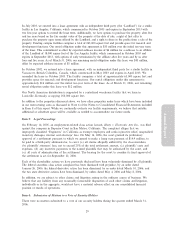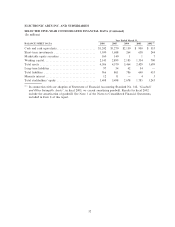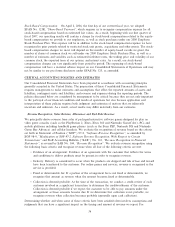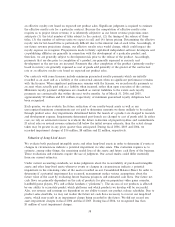Electronic Arts 2006 Annual Report Download - page 109
Download and view the complete annual report
Please find page 109 of the 2006 Electronic Arts annual report below. You can navigate through the pages in the report by either clicking on the pages listed below, or by using the keyword search tool below to find specific information within the annual report.
example, for multiple element arrangements, we must make assumptions and judgments in order to:
(1) determine whether and when each element has been delivered; (2) determine whether undelivered
products or services are essential to the functionality of the delivered products and services; (3) determine
whether vendor-speciÑc objective evidence of fair value (""VSOE'') exists for each undelivered element;
and (4) allocate the total price among the various elements we must deliver.
Changes to any of these assumptions or judgments, or changes to the elements in a software arrangement,
could cause a material increase or decrease in the amount of revenue that we report in a particular period.
Product revenue, including sales to resellers and distributors (""channel partners''), is recognized when the
above criteria are met. We reduce product revenue for estimated future returns, price protection, and other
oÅerings, which may occur with our customers and channel partners. In certain countries, we have stock-
balancing programs for our PC and video game system products, which allow for the exchange of these
products by resellers under certain circumstances. It is our general practice to exchange products or give
credits, rather than give cash refunds.
In certain countries, from time to time, we decide to provide price protection for both our PC and video
game system products. When evaluating the adequacy of sales returns and price protection allowances, we
analyze historical returns, current sell-through of distributor and retailer inventory of our products, current
trends in the video game market and the overall economy, changes in customer demand and acceptance of
our products and other related factors. In addition, we monitor the volume of sales to our channel partners
and their inventories, as substantial overstocking in the distribution channel could result in high returns or
higher price protection costs in subsequent periods.
In the future, actual returns and price protections may materially exceed our estimates as unsold products
in the distribution channels are exposed to rapid changes in consumer preferences, market conditions or
technological obsolescence due to new platforms, product updates or competing products. For example, the
risk of product returns and/or price protection for our products may continue to increase as the
PlayStation 2, Xbox and Nintendo GameCube consoles move through their lifecycles and an increasing
number and aggregate amount of competitive products heighten pricing and competitive pressures. While
we believe we can make reliable estimates regarding these matters, these estimates are inherently
subjective. Accordingly, if our estimates changed, our returns and price protection reserves would change,
which would impact the total net revenue we report. For example, if actual returns and/or price protection
were signiÑcantly greater than the reserves we have established, our actual results would decrease our
reported total net revenue. Conversely, if actual returns and/or price protection were signiÑcantly less than
our reserves, this would increase our reported total net revenue.
SigniÑcant judgment is required to estimate our allowance for doubtful accounts in any accounting period.
Annual Report
We determine our allowance for doubtful accounts by evaluating customer creditworthiness in the context
of current economic trends and historical experience. Depending upon the overall economic climate and
the Ñnancial condition of our customers, the amount and timing of our bad debt expense and cash
collection could change signiÑcantly.
Royalties and Licenses
Our royalty expenses consist of payments to (1) content licensors, (2) independent software developers
and (3) co-publishing and/or distribution aÇliates. License royalties consist of payments made to
celebrities, professional sports organizations, movie studios and other organizations for our use of their
trademarks, copyrights, personal publicity rights, content and/or other intellectual property. Royalty
payments to independent software developers are payments for the development of intellectual property
related to our games. Co-publishing and distribution royalties are payments made to third parties for
delivery of product.
Royalty-based obligations with content licensors and distribution aÇliates are either paid in advance and
capitalized as prepaid royalties or are accrued as incurred and subsequently paid. These royalty-based
obligations are generally expensed to cost of goods sold generally at the greater of the contractual rate or
37
























